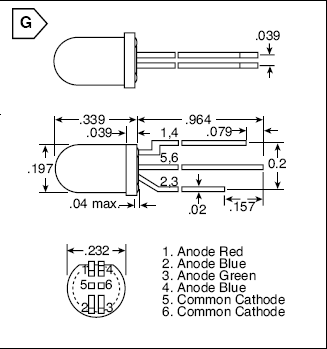The onboard Atmex LED is red, which is all fine and everything but we want to make other nifty colors. Like fuscia and turquoise and orangeyellow. There's no such thing as a fuscia LED, so instead we will take 3 LEDs (red, green & blue) and power them at different brightness to combine into a virtual rainbow. A lot of people are familiar with the "additive color wheel" diagram[1]: Red plus green is yellow. Red plus purple is magenta (purplish). Green plus blue is cyan (light bluish). Add them together and you make white.

Whats neat about the RGB LED is that the three different chunks of semiconductor are in one small plastic package. In order to wire up the LED properly, we need to look at the datasheet, like we did for the plain red LED. Only problem is, there doesn't seem to be one (well let me know if you find one for it, but I couldn't). There is some information in the mouser catalog, so lets read that.


Despite lacking a datasheet, pretty much all the data necesary is here. The forward voltages (Vf) of red, green and blue: 2V, 2.2V and 3.8V. The brightness, 90mcd, 70mcd and 12.5mcd. Note that there are 2 blue LEDs, probably to make up for the fact that each one is pretty dim.
The "cathode" of an LED is the part that always gets connected to ground (or is closest to ground): current in a diode wants to flow from the "anode" to the "cathode." One way to remember that is that, alphabetically, anode comes before cathode. The reason its called a "common cathode" is that all the LEDs are connected together to the two cathode pins. Its not really clear why there are two cathode pins, probably just easier to manufacture.
Lets calculate the resistor values we want for each LED. Say we want 10mA through each LED. That means that for the red LED, (5-2)V/0.01A = 300 ohms. For the green, (5 - 2.2)/0.01 = 280 ohms. Blue, (5 - 3.8)/0.01 = 120 ohms. Lets just say that 280 = 300, its pretty close anyways. OK we're ready to wire it up!
To start, lets use a solderless breadboard (the white slab thing) to wire up the LED. You don't have to breadboard the LED, its a rather simple circuit. But its also pretty common to screw things up (in general) and with a solderless breadboard, screwing up is easy to fix whereas if you solder the LED directly, before you know 100% that you're doing it right, well its a real pain to desolder and fix that sort of thing.
To start, clip the leads so they're all the same length, this just makes it to work with. Now bend the four anode leads so that are seperated like so.
And plug it into the breadboard so that you use up five rows.
Now clip and bend the two 300ohm and two 120ohm resistors and use them to bridge the two columns.
Now connect the cathodes to ground, and the green LED's resistor to port B2, the red one's to B3 and the two blue ones to B4.
If you want to test/play with the RGB led, take the wires that connect from the resistor to the port and try plugging them directly into 5V to light them up.
OK lets write some basic code to color mix:
00001 // this is the header file that tells the compiler what pins and ports, etc. 00002 // are available on this chip. 00003 #include <avr/io.h> 00004 00005 // define what pins the LEDs are connected to. 00006 // in reality, PB2/PB3/PB4 are also constants. e.g PB2 is 2 00007 #define GREEN PB2 00008 #define RED PB3 00009 #define BLUE PB4 00010 00011 // Some macros that make the code more readable 00012 #define output_low(port,pin) port &= ~(1<<pin) 00013 #define output_high(port,pin) port |= (1<<pin) 00014 #define set_input(portdir,pin) portdir &= ~(1<<pin) 00015 #define set_output(portdir,pin) portdir |= (1<<pin) 00016 00017 int main(void) { 00018 // initialize the direction of the B port to be outputs 00019 // on the 3 pins that have LEDs connected 00020 set_output(DDRB, RED); 00021 set_output(DDRB, GREEN); 00022 set_output(DDRB, BLUE); 00023 00024 // turn on RED and BLUE to make...magenta (purple)! 00025 output_high(PORTB, RED); 00026 output_low(PORTB, GREEN); 00027 output_high(PORTB, BLUE); 00028 00029 return 0; 00030 }This is pretty much just like the ledblink.c code, except we're not blinking and we're using different pins. Compile and upload it as before. Pretty simple. You can go through and experiment with mixing in different ways to make all 7 colors in the colorwheel. You'll note that the colors aren't exactly what they ought to be (particularly white)...this LED isn't really perfectly calibrated.
Now we go back & combine ledblink.c and the basic colormixing code to make a blinking colormix
00001 // this is the header file that tells the compiler what pins and ports, etc. 00002 // are available on this chip. 00003 #include <avr/io.h> 00004 00005 // define what pins the LEDs are connected to. 00006 // in reality, PB2/PB3/PB4 are also constants. e.g PB2 is 2 00007 #define GREEN PB2 00008 #define RED PB3 00009 #define BLUE PB4 00010 00011 // Some macros that make the code more readable 00012 #define output_low(port,pin) port &= ~(1<<pin) 00013 #define output_high(port,pin) port |= (1<<pin) 00014 #define set_input(portdir,pin) portdir &= ~(1<<pin) 00015 #define set_output(portdir,pin) portdir |= (1<<pin) 00016 00017 // this is just a program that 'kills time' in a calibrated method 00018 void delay_ms(uint8_t ms) 00019 { 00020 uint16_t delay_count = F_CPU / 17500; 00021 volatile uint16_t i; 00022 00023 while (ms != 0) { 00024 for (i=0; i != delay_count; i++); 00025 ms--; 00026 } 00027 } 00028 00029 00030 int main(void) { 00031 // initialize the direction of the B port to be outputs 00032 // on the 3 pins that have LEDs connected 00033 set_output(DDRB, RED); 00034 set_output(DDRB, GREEN); 00035 set_output(DDRB, BLUE); 00036 00037 while (1) { 00038 // start with all the LEDs off 00039 output_low(PORTB, RED); 00040 output_low(PORTB, GREEN); 00041 output_low(PORTB, BLUE); 00042 00043 // turn on the red light for 200ms 00044 output_high(PORTB, RED); 00045 delay_ms(200); 00046 00047 // turn on red & green -> yellow for 200ms 00048 output_high(PORTB, GREEN); 00049 delay_ms(200); 00050 00051 // now turn off red to make just green 00052 output_low(PORTB, RED); 00053 delay_ms(200); 00054 00055 // now turn on green & blue to make greenish-blue 00056 output_high(PORTB, BLUE); 00057 delay_ms(200); 00058 00059 // turn off green -> blue 00060 output_low(PORTB, GREEN); 00061 delay_ms(200); 00062 00063 // turn on red again to make purple 00064 output_high(PORTB, RED); 00065 delay_ms(200); 00066 00067 // now start over 00068 } 00069 }
- Change the blinking color mix code to blink out a customized set of colors and speeds (ie green, blue, white & turquoise)
